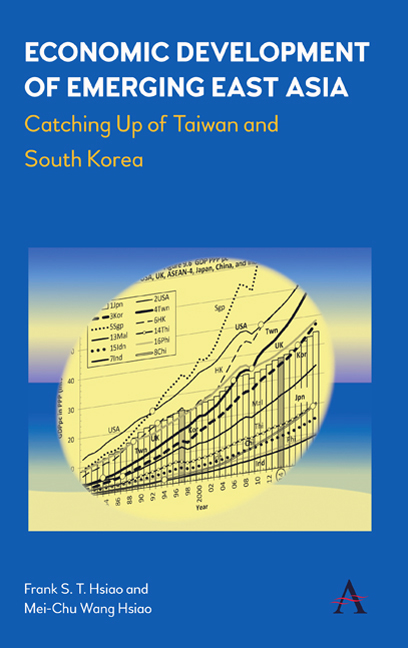Book contents
- Frontmatter
- Dedication
- Contents
- List of Figures
- List of Tables
- Sources of the Chapters
- Acknowledgments
- About the Authors
- Introduction
- Part I Studies of Emerging East Asian Economies: Taiwan and Korea
- Part II Catching Up and Convergence in East Asian Economic Growth
- 6 Miracle or Myth of Asian NICs’ Growth: The Irony of Numbers
- 7 “Miracle Growth” in the Twentieth Century: International Comparisons of East Asian Development
- 8 Catching Up and Convergence: On the Long-Run Growth in East Asia
- 9 Epilogue: From Emerging East Asia to an Asia-Centered World Economy
- Index
7 - “Miracle Growth” in the Twentieth Century: International Comparisons of East Asian Development
from Part II - Catching Up and Convergence in East Asian Economic Growth
Published online by Cambridge University Press: 10 January 2018
- Frontmatter
- Dedication
- Contents
- List of Figures
- List of Tables
- Sources of the Chapters
- Acknowledgments
- About the Authors
- Introduction
- Part I Studies of Emerging East Asian Economies: Taiwan and Korea
- Part II Catching Up and Convergence in East Asian Economic Growth
- 6 Miracle or Myth of Asian NICs’ Growth: The Irony of Numbers
- 7 “Miracle Growth” in the Twentieth Century: International Comparisons of East Asian Development
- 8 Catching Up and Convergence: On the Long-Run Growth in East Asia
- 9 Epilogue: From Emerging East Asia to an Asia-Centered World Economy
- Index
Summary
Abstract
Using Maddison's extensive long-run data, we compare levels and growth rates of real GDP per capita between Korea and Taiwan, along with Japan, and 53 other countries in the world, covering the prewar and postwar periods (1901– 92). Both countries, along with Japan, experienced very rapid growth in both periods, especially Korea, whose growth rates ranked third or fourth in the world in the prewar period.
After World War II, however, Korea fell steadily below Taiwan, and both fell continuously behind Japan until 1970 when they simultaneously began to catch up. Finally, using Perron's test, we analyze structural changes or continuity between the two periods. Both domestic and international economic conditions are examined to explain the findings. The gist of this chapter is that colonialism has unexpected results, and that the often-touted “rags to riches” or “Economic Miracle” of Taiwan and Korea is not a postwar phenomenon. It all started during the colonial period long before World War II, and both Taiwan and Korea took almost a century of development to become advanced countries of today.
Introduction
It is now well known that South Korea (hereafter referred to as Korea) and Taiwan are the only two noncity-state countries that have both achieved and maintained rapid modern economic growth since the end of World War II. The question “How did they do it, and can other developing countries learn from their experiences?” has been one of the most discussed and studied issues in recent economic literature. While recognizing the differences in their growth performance and industrial structures, most studies combine them as if they were twins, in consideration of both countries possessing similar cultural backgrounds, and having the status of Japanese colonies prior to World War II.
During the early 1990s, however, several “revisionists sought to trace various political and economic continuities between the Japanese colonial period and the rapid growth that began— or began again— in the 1960s” (Haggard, Kang and Moon, 1997, 867). The problem of continuity is important, as can be seen from Perkins's preface to Suh (1978): “a great deal happened to Korea's economy during that colonial period, and it is doubtful that one can really understand the current economic achievements without some knowledge of what went before.” This also has been pointed out by Kohli (1994), although it has been criticized by Haggard et al. (1997).
- Type
- Chapter
- Information
- Economic Development of Emerging East AsiaCatching Up of Taiwan and South Korea, pp. 177 - 224Publisher: Anthem PressPrint publication year: 2017



